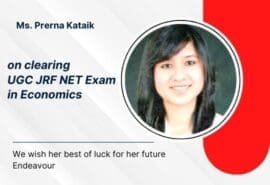
How Much Percentage is Required for CSIR NET Life Science?
How Much Percentage is Required for CSIR NET Life Science?
The Council of Scientific and Industrial Research National Eligibility Test (CSIR How much percentage is required for CSIR NET Life Science?
NET) Life Sciences is one of India's toughest postgraduate level examinations, with an average success ratio of 6-7% annually.
The competition is fierce, with lakhs of candidates vying for a few hundred Junior Research Fellowship (JRF) seats. Naturally, the key question troubling aspirants is - how much percentage do you need to score for qualifying and getting selected in this exam? Let's analyze the CSIR NET percentage required criteria in detail:
For CSIR NET Life Science Exam Preparation Coaching, contact us at Mantram Study Group, SCO No. 80-81, First Floor, Sector 15-D, Chandigarh (Near Gate No. 2, Panjab University Chandigarh – Contact – 9779797575/ 9463049859)
Exam Pattern
But before jumping into cutoff specifics, it is vital to comprehend the exam pattern, structure, and type of questions asked. Some key aspects are:
- Total Questions: 200
- Question Type: Objective multiple-choice questions
- Negative Marking: No negative marks
- Duration: 3 hours
Sections:
- General Aptitude - Mandatory qualifying
- Life Sciences Fundamentals: Compulsory qualifying
- Advanced Subjects: Based on specialization - Zoology, Botany, etc. Includes majorly applied questions testing analytical skills
Now that we understand the broader pattern let's discuss the all-important percentile required to ace this test across the two critical stages - Qualifying and Final Selection.
Qualifying Cutoff Percentage
To even enter the merit list race, you first need to secure the stipulated minimum percentile separately in two sections - General Aptitude and Life Science Fundamentals. This cutoff varies slightly yearly based on factors like difficulty level, no. of test takers, etc., but averages around 40-45%.
Some key aspects of the sectional qualifying cutoff are:
- General Aptitude has a negative mark. You must score a minimum of 40-45% here. Even 1 mark below the cutoff disqualifies you.
- In Life Sciences fundamentals, one must secure a minimum of 40-45% marks.
- Your advanced-level subject paper is evaluated further if qualifying marks are achieved in BOTH sections. Else, disqualified.
So, this initial double filtrating stage eliminates thousands needing more basic conceptual understanding or Aptitude. Survival depends on crossing the sectional cutoffs in Part A and B first.
Final Merit List Selection Percentage
Post the qualifying barriers, and now enter your core subject performance - Zoology, Botany, Biotechnology, etc.
-
Estimating JRF Selection Chances
For the Junior Research Fellowship award, you must make it to the top 2-5% scorers in the merit list, averaging around 65-67% marks in Part C advanced paper subject-wise.
Why such a high percentage for JRF? Again, the prime factor is intense competition, with lakhs attempting only a few hundred JRF seats across India. So, to emerge among the creme de la creme, nothing short of excelling with very high scores works.
- Lectureship Cutoff Percentage
The lectureship or LS cutoff percentages are reasonably relaxed as sufficient college teaching positions exist vis-a-vis limited JRF vacancies.
Generally, the LS cutoff hovers around 50% subject-wise post-qualifying in sections A and B. So those unable to score very highly in Part C advanced subjects can still qualify for college lectureship positions.
In Summary:
- Sectional cutoff in Parts A and B is around 40-45% - FAIL here, and the entire paper still needs to be evaluated.
- For JRF: Top 2-5% score around 65%+ subject-wise in Part C
- Lectureship: Minimum 50% in Part C subjects post A & B qualification
Analyzing Previous Cutoffs
To gauge the real picture, analyze PART C Advanced paper cutoffs of patches 2-3 years across Botany, Zoology, Biochemistry, etc. pr, providing clarity on subject-wise score fluctuations.
This percentage analysis of your core area reveals the qualifying score range - whether JRF or Lectureship.
Final Tips
- Master fundamentals for easily crossing qualifying cutoffs in sections A and B.
- For JRF selection, set a 70% subject-wise target minimum in PART C
- Consistency is vital. Even high achievers unable to score passing marks in PART A or B get eliminated sans full paper evaluation.
Wrapping Up
Cracking an intensely competitive examination like CSIR NET Life Sciences and qualifying for JRF requires thorough preparation to score very high percentages subject-wise.
Remember, your core advanced subject percentage is considered only after crossing initial aptitude and fundamentals qualifying barriers. Fail here, and the entire paper is disregarded.
While the LS or lectureship cutoff percentages are reasonably relaxed, around 50% subject-wise, students must aim higher for JRF selections. Competition is stiff, with lakhs writing but only a few hundred JRF seats. You must emerge among the top 2-5% scorers with at least 65%+ marks in the PART C section for bagging the Junior Research Fellowship.
So prepare extensively, understand the intricacies of the exam pattern, analyze previous cutoffs of your subjects, and set a scoring target for effectively cracking this challenging test! You can achieve this goal with an astute preparation strategy and determination.
Thanks for visiting our website Mantram Study Group
You may also join Mantram for NORCET Coaching
CHECK OUR OTHER LINKS: -
Testimonials
FAQ
Q. Who is eligible for CSIR Earth Science?
The Council of Scientific & Industrial Research (CSIR) conducts the National Eligibility Test (NET) for Earth Sciences, among other subjects, to determine eligibility for Junior Research Fellowships (JRF) and Lectureship/Assistant Professor positions in Indian universities and colleges.
Let's break down your queries:
Eligibility for CSIR Earth Science
The eligibility criteria for the Earth Sciences segment of the CSIR NET exam are quite specific. Candidates who wish to apply for the exam in this subject must meet one of the following academic qualifications:
BS-MS/BS-4 Years/M.Sc./B-Pharma or an equivalent degree in Earth Science. This broad category ensures that individuals with a strong foundation in Earth Science and related disciplines are eligible to apply.
Q. What is the meaning of the 82 percentile in CSIR NET?
When you receive a percentile score of 82 in the CSIR NET exam, you have outperformed 82% of the candidates who appeared for the exam. Percentile scores are a way to rank candidates relative to one another; a higher percentile means a higher ranking among all the test-takers. However, the statement that an "82 percentile means an approximate rank of 157404" seems to be based on a misunderstanding.
The rank is directly related to the number of candidates who appeared in the examination and their scores, not a fixed number like 157404 for the 82 percentile. Generally, an 82 percentile score would indicate a good performance, but the actual rank would depend on the total number of candidates and their distribution of scores.
Q. How many students qualify for CSIR NET every year?
Every year, over 2,000 candidates qualify for the Junior Research Fellowship (JRF) through the CSIR NET exam. This number varies depending on the performance of the candidates and the cut-off scores set by the CSIR for that year. The cut-off score is determined based on the overall performance. It is intended to select candidates with a high level of understanding and competency in their respective subjects.
The CSIR NET exam is a critical pathway for individuals pursuing research or academic careers in Earth Sciences and other scientific disciplines in India. The eligibility criteria ensure that candidates with a relevant educational background can apply. At the same time, the percentile score and cut-off marks determine who qualifies for the JRF and eligibility for the Lectureship/Assistant Professor positions.













































